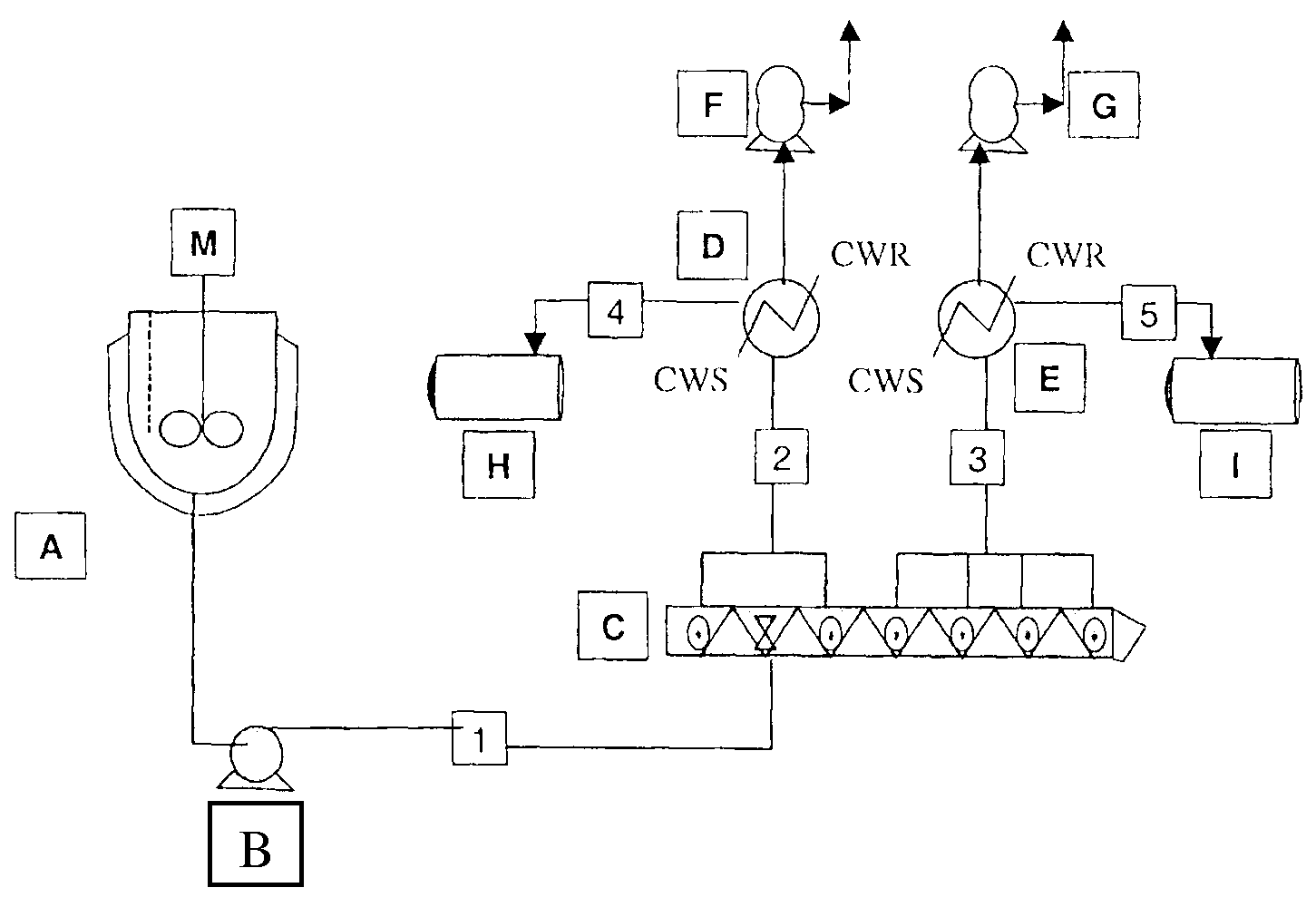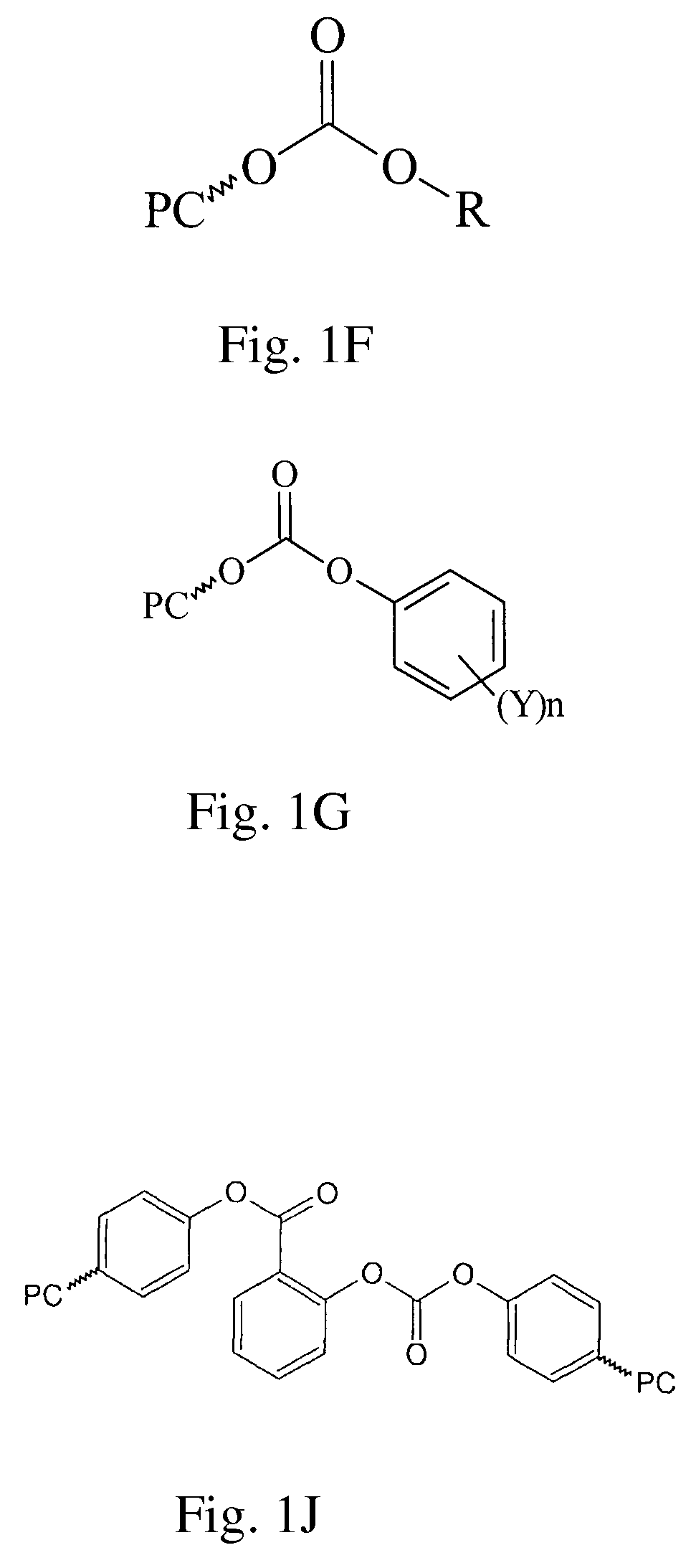Method of Preparing Polycarbonate
a polycarbonate and end group technology, applied in the field of preparing polycarbonate, can solve the problems of color, hydrolytic stability and thermal stability, unfavorable properties with respect to color, hydrolytic stability, etc., and achieve the effect of reducing the number of activated carbonate end groups and unfavorable properties
- Summary
- Abstract
- Description
- Claims
- Application Information
AI Technical Summary
Benefits of technology
Problems solved by technology
Method used
Image
Examples
example 1
[0176]Polymerizations were carried out in the reactor system shown schematically in FIG. 5. In this system the oligomerization vessel A is charged at ambient temperature and pressure with solid dihydroxy compound monomers, bisphenol A (HP), and optionally also hydroquinone, and methyl hydroquinone (terpolymer, TP); liquid BMSC. The mol % of monomers in the terpolymers was 33% BPA, 34% hydroquinone, and 33% methyl hydroquinone. Para-cumyl phenol (PCP) chainstopper was added in amount to yield approximately 30, 50 or 70 mol % of PCP end groups at the targeted PC molecular weight of 30,000 g / mol. The molar amount of additional BMSC employed was 0.5 times the molar amount of chainstopper. The catalysts tetramethyl ammonium hydroxide and sodium hydroxide were next added as an aqueous solution. The tetramethyl ammonium hydroxide at a concentration of 25 μEq / mol diol and the sodium hydroxide at a concentration of 4 μEq / mol BPA in the case of homopolymer and 2 μEq / mol BPA in the case of ter...
example 2
[0186]Experiments were carried out in accordance with Example 1, except that the amounts of activated diaryl carbonate relative to the combined amount of hydroxy groups from the dihydroxy compound and the monohydroxy chainstopper was varied, and the oligomerization temperature was varied as shown in Table 5. In the examples of the invention, the mole ratio of BMSC to (dihdroxy compound+½ monohydroxy compound) is maintained at a level less than 1 when expressed to three decimal places, for example 0.996 or less. In specific embodiments, the ratio is between 0.962 and 0.996, for example 0.968 to 0.996. In another specific embodiment, the ratio is between 0.971 and 0.994.
TABLE 5MonomerFormulationRatioMolar RatioBMSC / (Di-OH +BMSC / AromaticExamplePolymerPCP½ mono-OH)DiolsOligomerization T(° C.)WE 4HP50 0.9961.006150CE 6HP0n / a1.021170CE 7HP30>11.020170WE 5HP50>11.020170WE 6TP50 0.9981.008170CE 9TP0n / a1.018170CE 10TP30>11.020170WE 7TP50>11.020170
The characteristics of the polymers are s...
PUM
| Property | Measurement | Unit |
|---|---|---|
| mol % | aaaaa | aaaaa |
| mol % | aaaaa | aaaaa |
| molar ratio | aaaaa | aaaaa |
Abstract
Description
Claims
Application Information
 Login to View More
Login to View More - R&D
- Intellectual Property
- Life Sciences
- Materials
- Tech Scout
- Unparalleled Data Quality
- Higher Quality Content
- 60% Fewer Hallucinations
Browse by: Latest US Patents, China's latest patents, Technical Efficacy Thesaurus, Application Domain, Technology Topic, Popular Technical Reports.
© 2025 PatSnap. All rights reserved.Legal|Privacy policy|Modern Slavery Act Transparency Statement|Sitemap|About US| Contact US: help@patsnap.com



